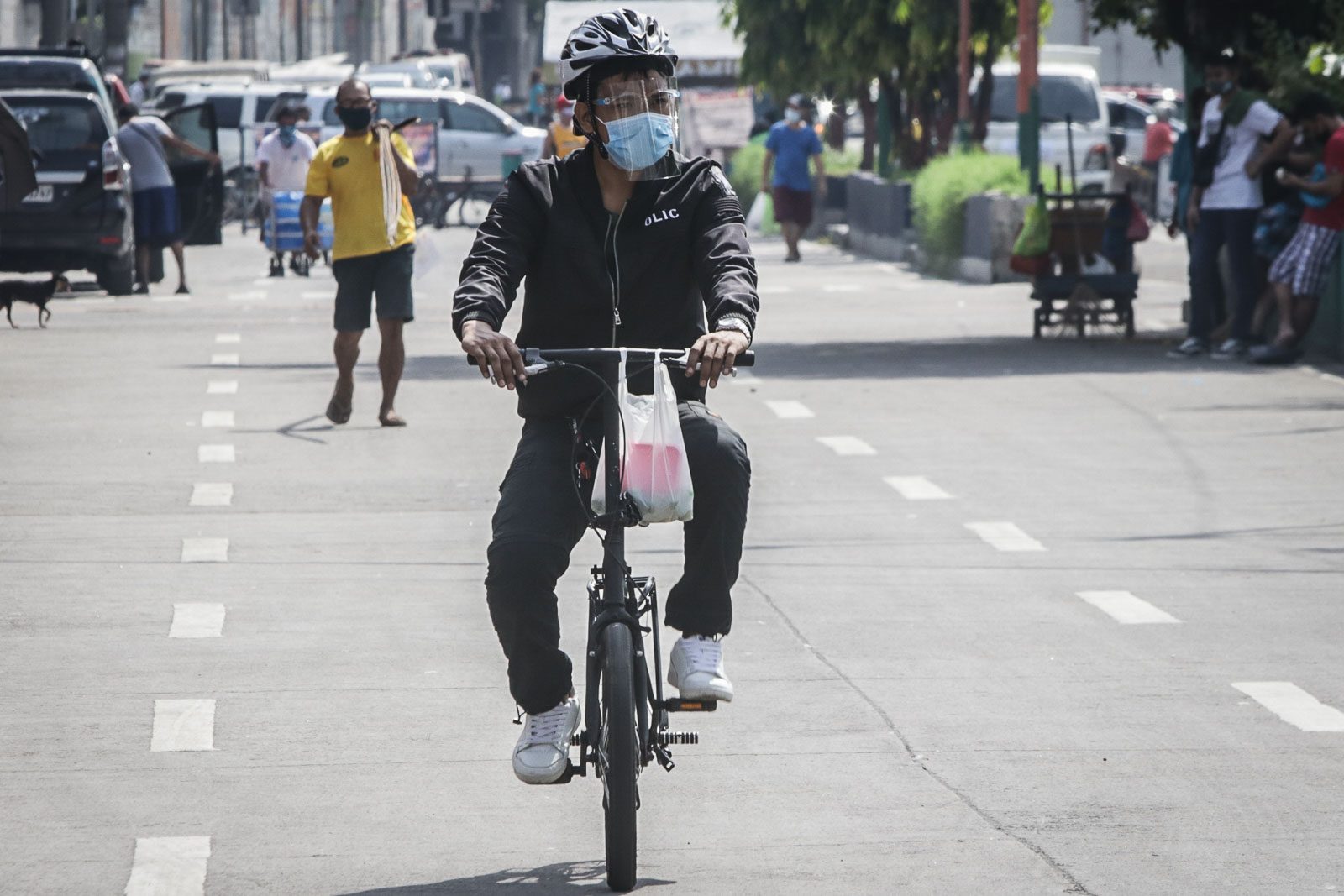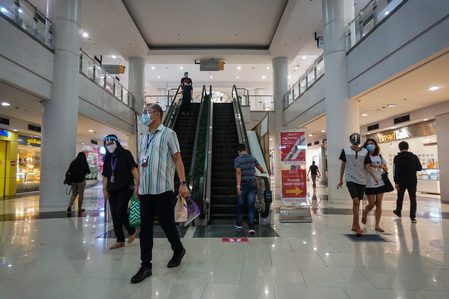SUMMARY
This is AI generated summarization, which may have errors. For context, always refer to the full article.

Months into the coronavirus pandemic, we’re all familiar with the various “CQs” that govern what we can and can’t do, depending on where we live.
The community quarantine classifications of enhanced community quarantine (ECQ), modified ECQ, general community quarantine (GCQ), and modified GCQ have become household terms.
How does the Philippine government, specifically the COVID-19 task forces, decide what CQ to declare over a city or province?
In September, the policy-making task force, the Inter-agency Task Force on Emerging Infectious Diseases (IATF-EID), formulated new parameters in deciding when to de-escalate or escalate the quarantine mode of a city or province.
This new criteria was needed because it was at this time when economic managers persuaded President Rodrigo Duterte and the Cabinet that reopening the economy was now a matter of survival, even if the virus was still spreading in the country.
The question on IATF-EID officials’ minds was, how do we change quarantine modes in a way that will allow businesses to safely reopen?
The IATF’s Sub-Technical Working Group on Data Analytics came up with new parameters in mid-September. In these parameters, the only time when a city or province will be elevated to a stricter quarantine mode is when the number of available COVID-19 beds and mechanical ventilators goes down significantly. In other words, when hospitals get overwhelmed.
Meanwhile, relaxing an area’s quarantine mode will now happen only when indicators show virus transmission decreasing and when things like the local government’s contact tracing, barangay health response, isolation capacity, and testing capacity are robust.
In this piece, we explain in more detail, how these parameters work. The information in this article comes from the presentations of Health Undersecretary Lilibeth David on October 29 and Dr John Wong, a consultant for the government coronavirus task force, on September 29.
Who makes the decisions and when?
It’s the IATF-EID that makes the initial recommendation on quarantine classifications for all cities and provinces. This decision is now made around the 20th of every month, according to David. She is part of the Sub-Technical Working Group on Data Analytics that provides the data used by its mother organization, the IATF-EID, to reach a decision.
At around the 25th of the month, local government units are told of the task force recommendation. They can submit an appeal if they oppose the proposed classification for their area.
President Rodrigo Duterte has the last say on the quarantine classifications for the month. He announces these around the last day of the month.
Decisions to de-escalate the classifications take place monthly. But decisions to escalate, or tighten restrictions in an area, are made twice a month. This is because the task force studies transmission indicators bi-monthly so this arrangement allows them to quickly tighten restrictions in a COVID-19 hot spot, without waiting for the monthly decision.
Before these new parameters were made, de-escalation and escalation decisions were made twice a month or every 14 days. But government officials said this frequency in changes isn’t good for the economy. Businesses and local governments need stability and predictability. If changes happen monthly instead, local economies can have a chance to adjust to new quarantine modes.
How they determine how risky your area is
The task force classifies cities and provinces according to the risk of COVID-19 infection there.
Two indicators they look at: average daily attack rate (ADAR) and two-week growth rate (2WGR).
The ADAR is the number of new cases in a city or province over a two-week period, divided by the population of the city or province.
The higher the ADAR of a place, the higher the risk of getting COVID-19 if you are there.
- Low risk: ADAR < 1
- Moderate risk: ADAR 1-7
- High risk: ADAR > 7
Two-week growth rate is the percent increase or decrease of the number of new cases in the past two weeks, compared to the number of new cases in the two previous weeks. It’s basically a comparison of the new cases detected one week ago and two weeks ago, and those new cases detected 3 weeks ago and 4 weeks ago.
If this growth rate is positive for a city or province, the epidemic is growing. If the rate is 0 or negative, the epidemic is stable or shrinking.
- Low risk: 2WGR < or = 0
- Moderate risk: 2WGR 0-200%
- High risk: 2WGR > 200%
The ADAR and 2WGR of an area are then cross-tabulated. This generates the final risk classification of that city or province – low, moderate, or high.
But ADAR and 2WGR are not the primary considerations for when to upgrade or downgrade a locality’s quarantine classification. They only give the task force an idea of how bad the coronavirus epidemic is in an area. This is then weighed against other factors explained below.
When to get stricter
There is now just one catalyst for your city or province to be placed under a stricter quarantine classification: healthcare utilization rate.
Healthcare utilization rate means the percentage of COVID-19 ward beds, isolation beds, critical care beds, and mechanical ventilators that are being used in a city or province at the time.
The following rates will trigger the corresponding quarantine modes:
- ECQ: 85% or more
- MECQ: 70-84%
- GCQ: 60-69%
Healthcare utilization rate that is lower than 60% means a city or province is ripe for the lowest quarantine classification of GCQ.
“So even if the cases in a place are increasing, if the health facilities can give adequate attention to these cases, we won’t escalate the conmunity quarantine,” explained David in an October 29 press briefing.
This critical statistic is computed before every 14th and 30th of the month so that government officials can decide whether to tighten restrictions in certain places.
When to loosen restrictions
It’s a different ballgame when the task force decides to lower the quarantine classification of a city or province.
One important consideration is the readiness of the city’s or province’s testing, isolation, and detection capabilities, what the task force calls “gatekeeping indicators.”
If these are deemed adequate, the national task force may decide that the city or province is ready for a more relaxed quarantine mode.
They measure this by looking at the number of trained epidemiology personnel, barangay health emergency responders, contact tracing teams, test positivity rate (must be less than 5%, the World Health Organization standard), and the ratio of isolation beds to population.
Steps in decision-making
Step 1: Officials look at the current quarantine classification of the city or province.
Step 2: They look at the state of healthcare utilization. If it reaches the thresholds (60%, 70%, and 85%), the quarantine mode may be escalated.
Step 3: They look at the risk classification based on ADAR and 2WGR.
Step 4: They consider other factors: how important the city or province is to regional economy, how many low-income families live there, unemployment rate, number of barangays with new infections in the last two weeks, number of active cases.
Undersecretary David explained why looking at the socioeconomic factors can affect the new quarantine classification of an area.
“Because sometimes, we want to place a stricter community quarantine in an area, but these areas contribute 45% to employment in the region or they contribute 28% to the region’s economy. So if that’s the case, it will be harder to elevate the community quarantine there,” she said.
In such cases, the task force could just decide to retain the present classification and order a boost to the health system capacity or stricter implementation of mask-wearing and social distancing rules.
This could be one reason why, though Davao City was said to have an 84% hospital occupancy rate in the two weeks before November 20, it was reverted to just GCQ.
An 84% healthcare utilization rate would have called for MECQ status. But Davao City is the biggest urban hub of Davao del Sur. Hundreds of thousands of people in the region are employed there. It’s the center of commerce and development.
Limits, caveats
But the quarantine classification system has limits.
The psychological impact of declaring an area under the most relaxed MGCQ is a factor considered by, for example, Metro Manila mayors.
They’ve asked for a retention of the GCQ status until the end of 2020, regardless of how well they’ll be able to rein in their outbreaks. They would rather gradually relax rules, like limits on restaurant dine-in or gym protocols, while still under GCQ. (READ: ‘Reclassifying’ businesses: Task Force’s way of reopening economy without changing quarantine modes)
The new parameters are a change from before, when case doubling time, test positivity rate, and reproduction number were the only numbers being considered.
As the pandemic evolves and with COVID-19 vaccines in the horizon, this may change yet again. – Rappler.com
Add a comment
How does this make you feel?

There are no comments yet. Add your comment to start the conversation.